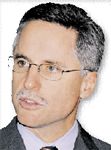Article
Primary hormonal therapy up, RP down, CaPSURE shows
Since its inception in 1995, the Cancer of the Prostate Urologic Research Endeavor has become one of the world's largest databases on prostate cancer. CaPSURE shows a rapidly evolving picture of how the disease is treated and the typical patient confronting it. In this exclusive Urology Times interview, Peter R. Carroll, MD, CaPSURE's principal investigator, discusses these trends and the forces driving them. The interview was conducted by UT Editorial Consultant Richard D. Williams, MD, professor and chairman of the department of urology, University of Iowa, Iowa City.
Since its inception in 1995, the Cancer of the Prostate Urologic Research Endeavor has become one of the world's largest databases on prostate cancer. CaPSURE shows a rapidly evolving picture of how the disease is treated and the typical patient confronting it. In this exclusive Urology Times interview, Peter R. Carroll, MD, CaPSURE's principal investigator, discusses these trends and the forces driving them. The interview was conducted by UT Editorial Consultant Richard D. Williams, MD, professor and chairman of the department of urology, University of Iowa, Iowa City.
Q What is CaPSURE?

A CaPSURE was launched in 1995. It now includes more than 10,000 patients and 120 urologists at approximately 28 to 31 sites around the country. Sites are broadly distributed geographically, but most are community sites. We have very few academic sites and one or two VA sites.
Q What is the reason for including more community sites than academic sites?

Q What is unique about the CaPSURE database?
A Again, I think what makes CaPSURE unique is that it tracks care in the community-the "average" care given to patients outside of clinical trials or academic medical centers. Unlike other large registries, it also tracks quality-of-life data that is patient derived. Even though we obtain information from physicians and hospitals, the patients receive questionnaires that they fill out at home.
Another nice feature of CaPSURE is that it allows us to look at subtle features that may predict for a certain type of treatment or outcome, for example, age, comorbidity, insurance status, region, education, income, and ethnicity. All these things are considered.
Q For urologists, what is the advantage of participating in CaPSURE?

Q How are the data accessed?
A Participating physicians can access their own data, as well as the aggregate data, via computer. All of the data are anonymous. We felt it was important to protect individual sites.
Q How were the practices chosen for inclusion in CaPSURE?
A Initially rather large practices were selected, and then an effort was made to increase geographic diversity. We also wanted to over-select for African-American and Latino men, so we chose practices that had a higher preponderance of men in these ethnic groups. Although CaPSURE may not be a perfect representation of American men with prostate cancer, I believe it comes closer than any other resource to meeting that standard.
Q Are you still looking for sites to participate?





